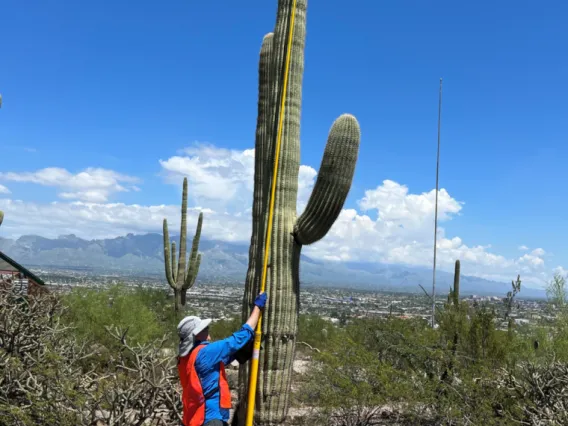The Future of the Saguaro- Research Project
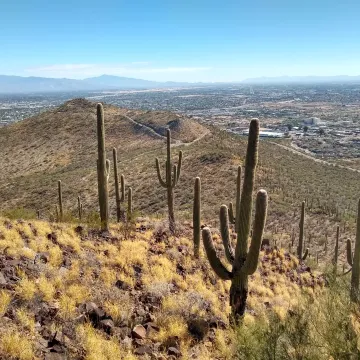
The saguaro (Carnegiea gigantea), the icon of the Sonoran Desert, is one of the most well studied plants in the world. However, fundamental questions remain, both ecological and methodological, that are directly relevant to desert parks and preserves such as Tumamoc Hill, Pinacate Biosphere Reserve, Organ Pipe Cactus National Monument, Saguaro National Park, Tonto National Monument, and others. How is the Sonoran Desert ecosystem responding to increased climatic variability now and into the future? How can we use the saguaro as a representative of Sonoran Desert ecology, to understand climate change in arid environments? How can we best utilize long-term data (growth rate, new individual recruitment, mortality, associated vegetation, and the local environment of each saguaro) to address questions related to the health and future of not only Tumamoc Hill saguaros, but across the range of the species?
The current project, funded in part by the National Park Service program, The Southwest Border Resource Protection Program, and being conducted under the auspices of Research Innovation and Impact via the Arizona Institute for Resilient Environments and Societies at the University of Arizona, is engaged in the following activities:
- The sixth repeat survey of approximately 4000 saguaros on the Tumamoc plots, collecting data for every individual such as height of the main stem, number of arms, condition, associated vegetation, and local ground and canopy cover, as well as searching for new saguaros and tracking mortality.
- Analyzing decades of survey data to better understand saguaro establishment patterns, saguaro mortality, and most likely future trends for saguaro populations.
- Developing better understanding of the impact of buffelgrass on saguaro populations.
- Collaborating with several researchers and National Park staff on combining other data sets from Saguaro National Park and 16 sites in Mexico to broaden our understanding of saguaro ecology and demographics across the entire species range.
- Writing peer-reviewed and non-scientist-oriented publications in collaboration with several researchers. These projects are investigating the small scale, medium scale, and large scale ecological and demographic patterns for the saguaro, as well as modeling the most likely future trends locally and across the species range.
- Promoting saguaro science and conservation through social media, public lectures, talks, presentations, and via the press.
- Hosting a workshop in April, 2023 of more than a dozen researchers in the United States and Mexico currently working in saguaro studies in order to explore the current state of understanding as well as develop future collaborative projects.
The Desert Lab looks forward to hearing from you if you have any questions or suggestions regarding this project. Contact postdoctoral researcher Peter Breslin at pbreslin@arizona.edu.
Historical Context
The Desert Laboratory monitors the height, growth, birth, and death of 5,280 IDed saguaros on Tumamoc Hill since 1964.
Shortly after establishing the Lab’s long-term vegetation plots, in 1908 Dr. Spalding mapped every saguaro on Tumamoc Hill and adjacent Sentinel Peak.
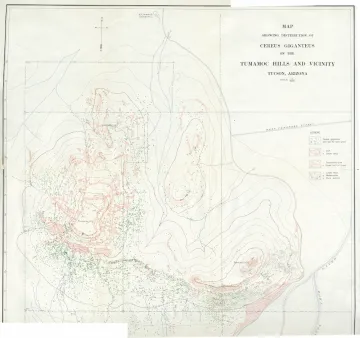
In 1964, James Rodney Hastings and Ray Turner established four large plots in the same area, on each cardinal direction, which the Lab still monitors today. Dr. Turner established ten additional long-term saguaro plots across the norther range of the species, which are mirrored in the southern portion of the saguaro’s range by plots established and maintained by Dr. Alberto Búrquez of the Instituto de Ecología in Mexico.
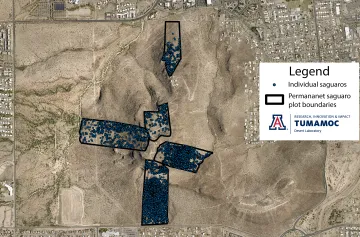
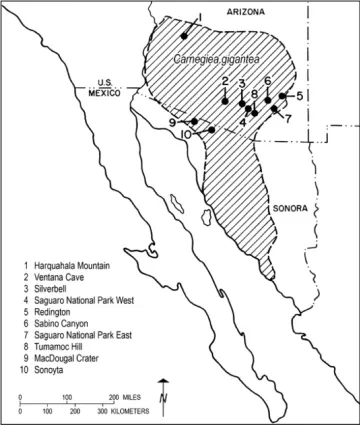
This research is done in collaboration with many scientists in the U.S. and Mexico across the range of this iconic species. A great deal of work, across scales, is helping establish the saguaro as a model system to understand the history and future of the desert.
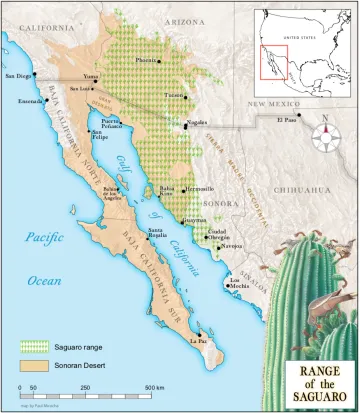
Paul Mirocha
The range of the saguaro. Map by Paul Mirocha, featured in the Proceedings of the Desert Laboratory, In the Arms of Saguaros.
Learn more of the scientific effort to reveal the history of a saguaro’s life, part of the Tumamoc Tour.


